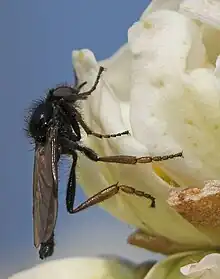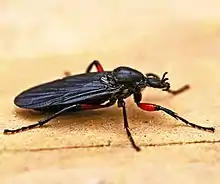| Bibio | |
|---|---|
 | |
| Bibio johannis | |
| Scientific classification | |
| Domain: | Eukaryota |
| Kingdom: | Animalia |
| Phylum: | Arthropoda |
| Class: | Insecta |
| Order: | Diptera |
| Family: | Bibionidae |
| Genus: | Bibio Geoffroy, 1762 |
| Type species | |
| Tipula hortulanus | |
| Species | |
|
see text | |
| Synonyms | |
| |

Bibio femoratus - March Fly
Bibio, March flies or St. Mark's flies, is a genus of flies (Diptera).
Biology
Bibio larvae live in grassy areas and are herbivores and scavengers feeding on dead vegetation or living plant roots. Some species are found in compost.[1]
In some areas, Bibio flies are regular flower visitors and they are suggested to be pollinators of several plant species,[2][3] such as hogweed (Heracleum sphondylium) and mouse-ear hawkweed (Hieracium pilosella).[4]
Bibio flies also show strong sexual dichotomy, with males and females having significant differences in body morphology.
Species
- B. abbreviatus Loew, 1864[5]
- B. acaptus Durrenfeldt, 1968[6]
- B. acerbus Yang & Luo, 1989[7]
- B. acutifidis Yang & Luo, 1989[7]
- B. albagulus Durrenfeldt, 1968[6]
- B. albipennis Say, 1823
- B. alexanderi James, 1936
- B. alienus McAtee, 1923[8]
- B. anasiformis Durrenfeldt, 1968[6]
- B. anglicus Verrall, 1869
- B. anposis Hardy, 1968[9]
- B. articulatus Say, 1823
- B. atrigigas Fitzgerald, 1997[10]
- B. atripilosa James, 1936
- B. baltimoricus Macquart, 1855
- B. basalis Loew, 1864[5]
- B. biconcavus Yang & Luo, 1989[7]
- B. borisi Fitzgerald, 1997[10]
- B. brunnipes (Fabricius, 1794)
- B. bryanti Johnson, 1929
- B. carnificus Durrenfeldt, 1968[6]
- B. carolinus Hardy, 1945
- B. carri Curran, 1927
- B. castanipes Jaennicke, 1867
- B. chelostylus Fitzgerald, 1997[10]
- B. chiapensis Fitzgerald, 1997[10]
- B. claviantenna Yang & Luo, 1989[7]
- B. clavipes Meigen, 1818
- B. cognatus Hardy, 1937
- B. columbiaensis Hardy, 1938
- B. constringutus Durrenfeldt, 1968[6]
- B. contererus Durrenfeldt, 1968[6]
- B. crassinodus Yang & Luo, 1989[7]
- B. cruciformis Durrenfeldt, 1968[6]
- B. cuneatus Yang & Luo, 1989[7]
- B. curtipes James, 1936
- B. deflectus Durrenfeldt, 1968[6]
- B. dipetalus Yang & Luo, 1989[7]
- B. discerptus Durrenfeldt, 1968[6]
- B. dolichotarsus Yang, 1997[11]
- B. dormitus Durrenfeldt, 1968[6]
- B. echinulatus Yang & Luo, 1989[7]
- B. elmoi Papp, 1982
- B. emphysetarsus Yang, 1997[11]
- B. enormus Durrenfeldt, 1968[6]
- B. femoralis Meigen, 1838
- B. femoraspinatus Yang, 1997[11]
- B. femoratus Wiedemann, 1820
- B. ferruginatus (Linnaeus, 1767)
- B. flavissimus Brunetti, 1925
- B. fluginata Hardy, 1937
- B. flukei Hardy, 1937
- B. fraternus Loew, 1864[5]
- B. fulvicollis Gimmerthal, 1842
- B. fumipennis Walker, 1848
- B. gineri Gil Collado, 1932
- B. graecus Duda, 1930
- B. handlirschi Duda, 1930
- B. hirtus Loew, 1864[5]
- B. holtii McAtee, 1922[8]
- B. hortulanus (Linnaeus, 1758)
- B. illaudatus Hardy, 1961
- B. imitator Walker, 1835
- B. imparilis Hardy, 1959
- B. inacqualis Loew, 1864[5]
- B. johannis (Linnaeus, 1767)
- B. kansensis James, 1936
- B. knowltoni Hardy, 1937
- B. labradorensis Johnson, 1929
- B. lanigerus Meigen, 1818
- B. latiantennatus Durrenfeldt, 1968[6]
- B. laufferi Strobl, 1906
- B. lautaretensis Villeneuve, 1925
- B. lepidus Loew, 1871
- B. leucopterus (Meigen, 1804)
- B. lobata Hardy, 1937
- B. longipes Loew, 1864[5]
- B. lugens Loew, 1864[5]
- B. macer Loew, 1871
- B. marci (Linnaeus, 1758)
- B. medioalbus Durrenfeldt, 1968[6]
- B. melanopilosus Hardy, 1936
- B. mickeli Hardy, 1937
- B. monstri James, 1936
- B. nebulosus Durrenfeldt, 1968[6]
- B. necotus Hardy, 1937
- B. nervosus Loew, 1864[5]
- B. nigrifemoratus Hardy, 1937
- B. nigripilus Loew, 1864
- B. nigripilus Loew, 1864[5]
- B. nigriventris Haliday, 1833
- B. obediens Osten Sacken, 1881
- B. obscurus Loew, 1864[5]
- B. painteri James, 1936
- B. pallipes Say, 1823
- B. picinitarsis Brulle, 1832
- B. pingreensis James, 1936
- B. plecioides Osten Sacken, 1881
- B. pomonae (Fabricius, 1775)
- B. praecidus Durrenfeldt, 1968[6]
- B. reticulatus Loew, 1846
- B. rufalipes Hardy, 1937
- B. rufipes (Zetterstedt, 1838)
- B. rufithorax Wiedemann, 1828
- B. rufitibialis Hardy, 1938
- B. sericata Hardy, 1937
- B. shaanxiensis Yang & Luo, 1989[7]
- B. siculus Loew, 1846
- B. siebkei Mik, 1887
- B. sierrae Hardy, 1960
- B. similis Durrenfeldt, 1968[6]
- B. similis James, 1936
- B. slossonae Cockerell, 1909
- B. soldatus Durrenfeldt, 1968[6]
- B. striatipes Walker, 1848
- B. tenella Hardy, 1937
- B. tenuis Durrenfeldt, 1968[6]
- B. thoracicus Say, 1824
- B. townesi Hardy, 1945
- B. tripus Durrenfeldt, 1968[6]
- B. tristis Williston, 1893
- B. utahensis Hardy, 1937
- B. variabilis Loew, 1864[5]
- B. variicolor Yang & Luo, 1989[7]
- B. varipes Meigen, 1830
- B. velcida Hardy, 1937
- B. velorum McAtee, 1923[8]
- B. venosus (Meigen, 1804)
- B. vestitus Walker, 1848
- B. villosus Meigen, 1818
- B. vixdus Durrenfeldt, 1968[6]
- B. xanthopus Wiedemann, 1828
- B. xuthopteron Hardy, 1968[9]
References
- ↑ Freeman, Paul; Lane, Richard P. (1985). "Bibionid and Scatopsid flies, Diptera: Bibionidae & Scatopsidae". Handbooks for the Identification of British Insects. 9 (7): 74.
{{cite journal}}: Cite journal requires|journal=(help) - ↑ Peter Goldblatt; John C. Manning & Peter Bernhardt (July 2005). "The Floral Biology of Melasphaerula (Iridaceae: Crocoideae): Is This Monotypic Genus Pollinated by March Flies (Diptera: Bibionidae)?". Annals of the Missouri Botanical Garden. 92 (2): 268–274. JSTOR 3298518. INIST 16975891.
- ↑ Flies and flowers II: Floral attractants and rewards Woodcock et al. (2014) Journal of Pollination Ecology 12:63-94
- ↑ Van Der Kooi, C. J.; Pen, I.; Staal, M.; Stavenga, D. G.; Elzenga, J. T. M. (2015). "Competition for pollinators and intra-communal spectral dissimilarity of flowers". Plant Biology. 18 (1): 56–62. doi:10.1111/plb.12328. PMID 25754608.
- 1 2 3 4 5 6 7 8 9 10 11 Loew, Hermann (1864). "Diptera Americae septentrionalis indigena. Centuria quinta". Berl. Entomol. Z. 8 (1–2): 49–104. doi:10.1002/mmnd.18640080105. Retrieved 9 August 2017.
- 1 2 3 4 5 6 7 8 9 10 11 12 13 14 15 16 17 18 19 20 Durrenfeldt, A. (1968). "Dipteren aus dem Oberpliozan von Willershausen". Beih. Ber. Naturhist. Ges. Hannover. 6: 43–81.
- 1 2 3 4 5 6 7 8 9 10 Yang, C.-k.; Luo, K. (1989). "New species and new records of March flies from Shaanxi, China (Diptera: Bibionidae)". Entomotaxonomia. 11: 141–156.
- 1 2 3 McAtee, W. L. (1923). "Descriptions of Bibio (Diptera) from the Carolinas". Proceedings of the Entomological Society of Washington. 25: 62–64. Retrieved 10 August 2017.
- 1 2 Hardy, D. E. (1968). "Bibionidae (Diptera) of New Guinea" (PDF). Pacific Insects. 10 (3–4): 443–513. Retrieved 12 August 2017.
- 1 2 3 4 Fitzgerald, Scott J. (1997). "A revision of Bibio (Diptera: Bibionidae) of Mexico and Central America". Transactions of the American Entomological Society. 123 (4): 225–287.
- 1 2 3 Yang, C.-k. (1997). Diptera: Bibionidae. Pp. 1441-1447. In Yang, X. (ed.), Insects of the Three Gorge Reservoir area of Yangtze River. Part 2. Chongqing: Chongqing Publ. House. pp. [4]+x+975–1847+[1].
This article is issued from Wikipedia. The text is licensed under Creative Commons - Attribution - Sharealike. Additional terms may apply for the media files.